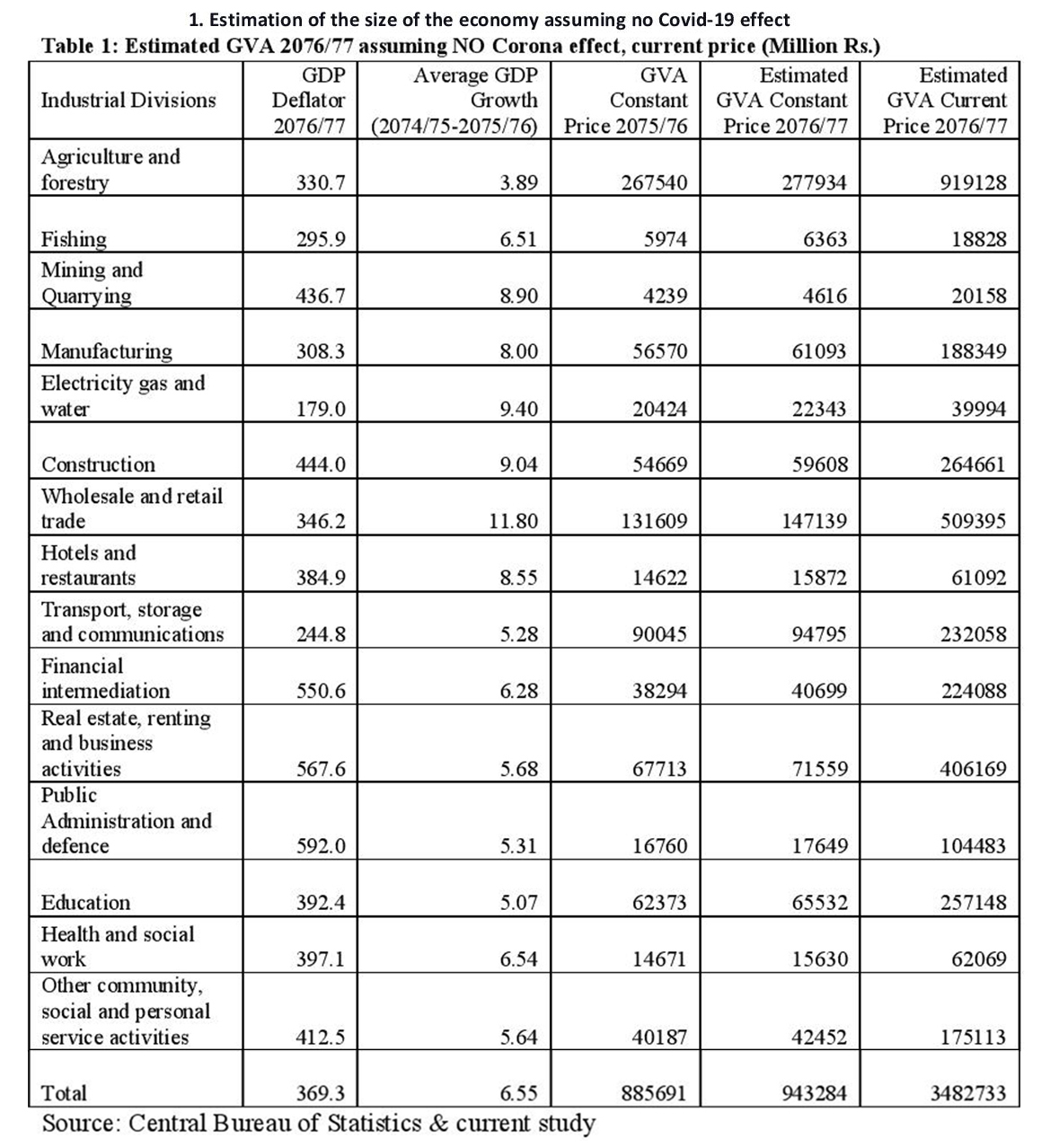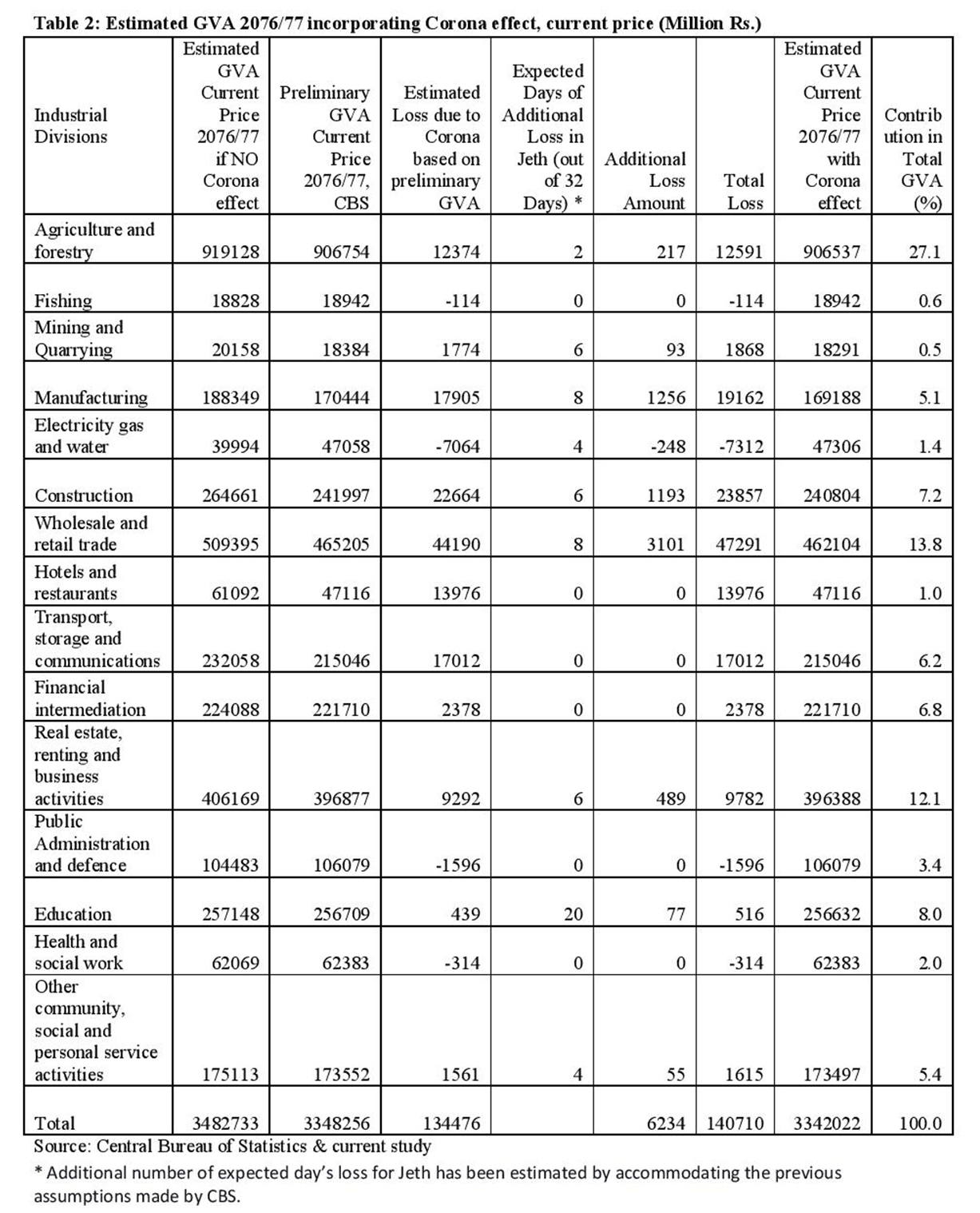0%

The economic impact resulted from the Covid-19 pandemic is huge and simply unbearable. The Government of Nepal imposed a nationwide lockdown from March 24 to control the spread of coronavirus and since then all sectors of the economy are adversely affected.
The pandemic-led lockdown affected the daily life of every individual. Obviously, the Nepalese economy has faced a huge loss.
According to the Central Bureau of Statistics (CBS), the central agency for the collection, consolidation, processing, analysis, publication and dissemination of authentic statistics in Nepal, the economic growth rate of this year is 2.27%. With the prolonged lockdown, the growth rate is expected to face worse moments ahead.
However, as the government has lifted the lockdown, all business houses are back to operation. But the issue is: can the formal lifting of the lockdown restore economic health fast enough?
The past economic activities give the impression that even if there had been no Covid-19 effect in Nepal, an 8% economic growth target set by the government was not possible to achieve.
Although markets are open now, demand and supply chains have not been back to normal. Consumers are not able to reach the market due to lack of public transportation and due to the fear of coronavirus.
Despite the fact that the government has allowed the use of public transportation, with a vehicle carrying passengers half of its capacity, public vehicles are still not seen in full operation.
Similarly, due to the low to lack of business transactions, numerous enterprises have been forced to shut down. Alongside this, new entrepreneurs are facing greater difficulties to enter the market.
Even export has been stagnant more than usual and at the same time import has also decreased. Overall, this has been a big hurdle for businesses to get back to normal.
Study Methodology
Everyone is aware that the Covid-19 has adversely affected the Nepalese economy as in the other parts of the world, yet, still the official figures on the impact of Covid-19 on the economy is not available.
The past economic activities give the impression that even if there had been no Covid-19 effect in Nepal, an 8% economic growth target set by the government was not possible to achieve. In such circumstances, estimating the economic loss due to Covid-19 seems to be a tricky task.
This study has attempted to estimate the impact of Covid-19 on the Nepalese economy by estimating the size of the economy with and without the Covid-19 effect.
To do this, the National Accounts estimates published by the Central Bureau of Statistics (CBS) have been used.
The Gross Value Added (GVA), Gross Domestic Product (GDP) Deflator, and past fiscal years’ GDP growth by all 15 industrial divisions have been used for the estimation.
In terms of the recent years’ economic growth in Nepal, the FY 2074/75 and 2075/76 can be considered as normal periods (GDP growth rate at basic price 6.35 and 6.75 percent respectively).
The GDP growth in the FY 2073/74 seems to be very high (7.74%) because of the effect of low economic growth in the FY 2072/73 (0.20%). The low GDP growth in FY 2072/73 was because of the devastating earthquake in Nepal in the year 2072.
Hence GDP growth rate of the FY 2074/75 and 2075/76 have been taken as the reference years for the estimation process in this study.
Estimation of the size of the economy assuming no Covid-19 effect

Estimation of the size of the economy with consideration of Covid-19 effect

Key Findings
This study found that if there were no effect of Covid-19 in Nepal, the size of Nepal’s economy in the FY 2076/77 at current prices would have been NRs. 34 Kharab 82 Arab 73 Crore and 20 Lakh.
This is an increase of NRs. 4 Kharab 33 Arab 27 Crore and 20 Lakh compared to the FY 2075/76. However, 114-days lockdown has led to a significant impact on the country’s economy.
The 114-day lockdown is estimated to have shrunk the size of the economy to Rs. 33 Kharab 42 Arab 2 Crore and 20 Lakh. As a result, the national economy has to bear a total of Rs. 1 Kharab 40 Arab 71 Crore loss.
This means that the lockdown in Nepal’s economy has caused a daily loss of Rs. 1 Arab 23 Crore and 40 Lakh (derived from Table 2).
According to the industrial classification, the top five industrial sectors that have suffered the most losses are Wholesale and retail trade (Rs. 47 Arab 29 Crore and 10 Lakh), Construction (Rs. 23 Arab 85 Crore and 70 Lakh), Manufacturing (Rs. 19 Arab 16 Crore and 20 Lakh), Transport, storage and communications (Rs. 17 Arab 1 Crore and 20 Lakh), hotels and restaurants (Rs. 13 Arab 97 Crore and 60 Lakh).
These five industrial sectors account for 86% of the total loss. It should be noted that the halt on tourism has adversely affected the hotels and restaurants, wholesale and retail trade and transport, storage and communications sectors (Figure 1).

The sector that contributes the most to the Gross Value Added, namely agriculture and forest, is estimated to be in the sixth place with a total loss of Rs. 12 Arab 69 Crore and 10 Lakh.
Interestingly, despite the lockdown, areas such as electricity, gas and water, public administration and defence, health and social work, and fishing appear to be making profit.
If we look at the share of industrial classifications in the overall Gross Value Added, agriculture and forestry have contributed the most (27.1%).
It is followed by wholesale and retail trade (13.8%), real estate, renting and business activities (11.9%), education (7.7%), financial intermediation (6.6%), construction (7.2%), and transport, storage and communications (6.4%). The share of manufacturing and hotels and restaurants is estimated to be 5.1% and 1.4% respectively.
We can also see the contribution/composition of the GVA by broad economic activity: extraction of raw materials (primary), production (secondary), and services (tertiary).
The primary sector activities are hence the activities related to the agriculture and forestry, fishing and mining and quarrying. Similarly, the secondary sector activities contain manufacturing, electricity, gas and water and construction.
The tertiary sector activities are the addition of wholesale and retail trade, hotels and restaurants, transport, storage and communications, financial intermediation, real estate, renting and business activities, public administration and defence, education, health and social work and other community, social and personal service activities.
This study showed that tertiary sector is the largest contributor in the economy with 58.1% share (GVA 1940955 million Rs.). The second largest contributor is the primary sector, 28.2% share contributing 943770 million Rs. GVA. The secondary sector contributes 13.7% share in the economy with GVA 457298 million Rs. (Figure 2).

Alternatively, we can also interpret this as follows: in every 7 parts of the economy, secondary sector (production) contributes 1-part, primary sector (extraction of raw materials) contributes 2-parts and tertiary sector (service) contributes 4-parts.
Way Forward
The findings of this study show how lockdown has been a hurdle for our economic growth. During 4 months of lockdown, the general public has suffered a socio-economic crisis as never before.
Although, the government has announced the end to the nationwide lockdown enforced since March 24, reviving the broken economy is most likely to be a tough job to the government.
The agricultural sector has offered the biggest contribution to the economy during this hard time. Fortunately, the impact of Covid-19 pandemic in this sector is minimal or neutral.
It seems that this sector needs to be commercialized with much more priority. Likewise, in order to rehabilitate the areas badly affected by Covid-19, the government should work in partnership with private sectors and international agencies in coordinated ways so that it will be possible to formulate effective plans and policies and implementation.
The new fiscal year has started and we hope the government is already prepared to introduce and effectively implement their plans to restructure the economy.
Every crisis could also be seen as an opportunity to think out of the box, innovate and plan better for future. Nepal cannot and should not be complacent and be proactive in combatting the Covid-19, a public health crisis, with huge impact on economy.
The question lies in: ‘Is the government ready to bring positive change with effective and realistic plans and policies to revive the economy?”
(With inputs from Archana Neupane)